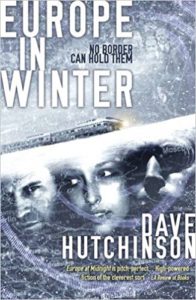I should say two things right up front about Europe in Winter. First, intermittently during a bicycle tour across one of Europe’s smaller polities that steadfastly refuses to disappear completely is both the right and wrong way to read this book. Wrong, because it surely deserves closer attention that I was sometimes able to give it on mid-stage breaks or evenings at the campgrounds. I am sure I missed things, possibly even important things, for it is a subtle and uncompromising work. Right because I kept crossing old borders that are still there if you know to look for them, as Hutchinson’s main character Rudi (or Ruudi in his native Estonian, as readers learn in this volume) has learned to look in the course of the two previous books about fractured Europe (Europe in Autumn and Europe at Midnight). The death strip between East and West Germany is long gone, but as the train wends its way through southern Thuringia on the way to Bavaria, settlements dwindle and there is far more forest than anything else. It’s not hard to imagine that the topology of the hills might lead to some of the unexpected places that characters in Hutchinson’s book find themselves in after a funny turn in the Warsaw Metro or the Estonian woods. Bavaria itself, once reached, proves unreliable, or at least not as unitary as it appears from a distance. Franconian flags and coats of arms appear in the towns, but even that fractures into Ober- Mittel- and Unterfranken if one asks the local people. Cities remember their old Imperial freedoms, Baroque palaces perch on the sites of older fortresses atop high hills, and Germany’s old Kleinstaaterei seems just around the next bend. After ten days or so, Legoland appears, brighter, louder and shinier than any place in Hutchinson’s down-at-the-heels Europe but its own country in a sense, distant cousin to the extraterritorial railroad, the Line, that plays a key role in the novel.
Second, for me it was worth reading the whole novel, possibly the whole series, just to have a chapter called “The Justified Ancients of Muhu.” The tip of the beanie to Robert Shea and Robert Anton Wilson is lovely, and I liked it all the more because I have spent more than time than one would expect on the Estonian island of Muhu. I, too, have failed to have a dinner at the gorgeous estate where Rudi misses a long-planned meal, though for less deadly reasons.
The action of the novel kept crossing my path in other places. There is a long set piece in Esztergom, where the Danube stops dividing Hungary from Slovakia, turns south and dives toward Budapest. The first time I was there, Hungary was still a People’s Republic, yet another vanished polity. Another chapter is titled “The Pink Palace,” drawn on the notion that the people of Warsaw decided to paint the Palace of Culture and Science that is still a prominent part of the skyline, half a century after Stalin presented it to city that certainly hadn’t asked for it, a vibrant pink. The chapter shares a name with a legendary youth hostel on Corfu, where the party has been going strong for decades. I’m sure there are more references of this sort in the book, slipped in for the amusement of those who know about such things.
The book’s multiple storylines deepen the sense of Europe’s fracturing and entering a new era, now that the Community is openly acknowledged. Rudi learns more about himself, about his family, about his family’s history and how it is twined with Europe’s history. Some other characters are seen only briefly, to illustrate a particular aspect, or to advance the interactions between Europe and its counterparts across esoteric borders. Some things that had appeared solid in the other books turn out to be hollow, and vice versa.
The topology of this book is not simple, which fits perfectly with its subject and themes. Hutchinson approaches some of the incidents sideways, folding them and stretching them; sometimes a climax is just a local maximum, and it is far from clear whether it holds that role in the overall shape of the series.
“It never tied things up nearly; no one ever got to see the whole story, and anyway the stories never ended, just branched off into infinity. You got used to that too, as a Coureur. You jumped a Package from Point A to Point B and you never knew what happened after that. Most of the time you never even knew what you were carrying.”
The glimpses, though, are terrific. The notions are fascinating. And there are hints of more to come. I’m keen to see what light Europe at Dawn may shed.

